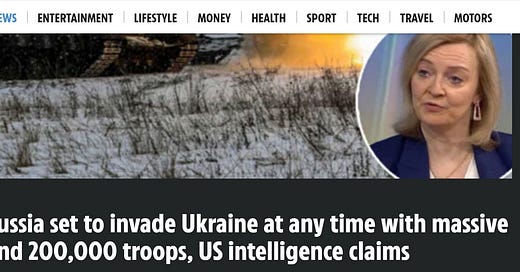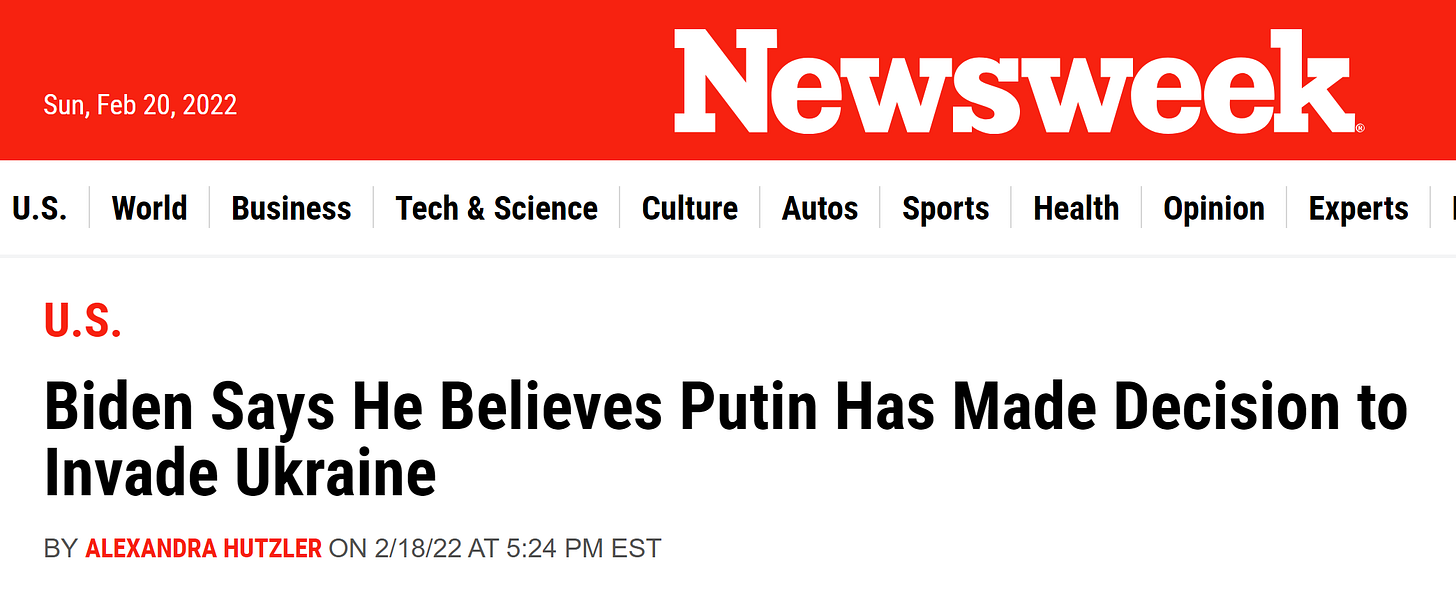“I tell you, on the day of judgment people will give account for every careless word they speak, for by your words you will be justified, and by your words you will be condemned.” -Jesus
For the past few weeks I’ve been pointing out the holes in the claim that Russia will strike Ukraine at any moment. Take note that in that time, Russia has not invaded, despite the U.S. setting a date, despite nothing materializing, and despite returning to the “any day” narrative once again.
It started with Biden himself – along with several unnamed U.S. officials – who said February 16 would likely be the day of a massive attack. It was a dud.
At time of writing, the U.S. has doubled (tripled?) down and is now saying the order to invade has been given, despite the fact that Putin and Biden just accepted an invitation to meet with one another and hash things out. It doesn’t get any more Wag the Dog than this.
The fact that Biden has said on record that he is convinced Russia will invade Ukraine may become a defining moment of his presidency when it doesn’t pan out.
I’ve also systematically pointed out the evidence that suggests this information warfare is not primarily Russia’s doing, but represents the concerted efforts of politicians and intelligence in the West. We now have more data that confirms this is the case.
Frustrated with the weaponization of his country, President Zelensky of Ukraine recently demanded proof of U.S. intelligence claims of an imminent invasion. Later, he even took to Facebook to post ironically about the February 16 date set by Biden. His aides then felt the need to inform Western media that Zelensky, a former comedian, was only having fun with the alarmist rhetoric being directed at his country.
Ukraine's own Defense Minister Oleksii Reznikov defied provocative Western claims of imminent invasion, saying, “Our intelligence sees every move that could pose a potential threat to Ukraine. We estimate the probability of a large-scale escalation as low.”
And while the U.S. media framed Zelensky’s remarks at the Munich Security Conference as a desperate call to be admitted to NATO, the sentiment was rather one of indignation at the West for its reckless, feckless posturing.
"You are telling me it's 100 percent that the war will start in a couple of days. Then what are you waiting for [to implement sanctions],” he said. You can view the full Q&A here.
In that same Q&A he calls the narrative around the recent shelling of a kindergarten in Eastern Ukraine “pure lies” and “cynicism of such a high level.” He’s unhappy with both pro- and anti-Russian accusations, it seems, because fighting in the Donbas is, sadly, nothing new and relatively constant.
He brushes off what the Western voices have been whispering to him about imminent invasion and boldly counters, “The intelligence I trust is my intelligence. I trust Ukrainian intelligence.”
Russian news agency TASS pokes fun that even the President of Czech Republic (a NATO member!) doubts the quality of CIA claims.
"As for US intelligence agencies, this is their third fiasco,” said Czech President Milos Zeman, citing WMD in Iraq as their first, and the catastrophic pull-out from Afghanistan as their second.
Perhaps the silliest take on this past week’s shelling in the Donbas came from UK Prime Minister Boris Johnson. He said they know it was a false flag operation designed to discredit the Ukrainians and create a pretext for Russian action.
First of all, no kids were hurt and no one was killed. No one wants any shelling to happen, and everyone wants peace for the region. No doubt.
But how could you ask for a better photo op for U.S. media to double down on the narrative of pro-Russian aggression than a giant hole blown out of the side of a kindergarten? Moreover, Boris Johnson’s reaction is not only a pitiful acting performance that repeats, unconvincingly, intelligence talking points almost word-for-word, but it also doesn’t make any sense.
The kindergarten is on the Ukrainian-controlled side of the fighting, and he thinks it’s specifically a false flag by the pro-Russian separatists? A false flag is a strategy to create an incident and make it look like someone else did it. Why would the separatists stage a bombing of a Ukrainian-controlled kindergarten and pin it on…the Ukrainians?
It would be like stabbing someone you really don’t like and telling the police, “Look, they stabbed themselves! Now I should be able to stab them some more.” It’s that level of silliness.
If Boris had any understanding of the situation, he would have simply come out and condemned this horrific attack on Ukrainians and, thus, easily reinforced the narrative about the evil Russian empire.
Perhaps that’s one of the reasons his career is said to be in freefall.
Lastly, we now know that the “intelligence” that U.S. agencies are getting about an imminent invasion does not come from some highly secretive network of sources, but rather from a general feeling about who Putin is as a person. That is not a joke (because unlike Zelensky, I am not a comedian).
Sir John Sawers, former Chief of MI6, came right out and said it in this dutiful interview with the Atlantic Council, which is a member of the Atlantic Treaty Association, an umbrella organization bringing together anyone and everyone in support of NATO.
And he doesn’t stop there. He wraps up the whole enchilada for us:
“What has been released – the idea that Putin might want to dislodge Zelensky and replace him with a puppet government or that he is going to contrive a pretext for Russian intervention in the East of Ukraine – these are based on a growing understanding, an analysis, of Putin rather than deep secret intelligence reports. And I think wrapping them up as intelligence and adding a few juicy names to the reporting just gives some good stories for the media and helps push back against the narrative. It’s a skillful use of information and analysis to turn the tables on Putin and his own ability to dominate the airwaves.”
Juicy, indeed. Did you know that the Russians are now drawing up kill lists – KILL LISTS – to carry out upon invasion? This information comes to you courtesy of four unnamed people familiar with U.S. intelligence who will never be identified and will suffer no reputational harm when these unverifiable kill lists are never discovered.
This brings me to my final point. U.S. officials have repeatedly stated that calling out all these deadly plans being drawn up by Putin in some dark, creepy corner of the Kremlin will act as a deterrent to invasion. They have been on an “unprecedented” declassification campaign that they say is designed to discourage Putin from going forward with his plans. But will all of this talk about missiles, mass casualties, kill lists, cyber warfare, and imminent invasion actually deter or inflame?
Apart from the fact that the U.S. wins either way (if Putin invades they were right; if he doesn’t invade they successfully deterred him), I don’t see how the world is any safer because of this information warfare, much less beneficial to Ukrainians trying to live their lives in peace.
The humongous effort to renew a challenge with Russia is part of a larger, and in my view, misguided, approach to how the U.S. interacts with certain world powers. For some time, according to Secrets Machine, there has been a “major shift underway in the Pentagon to refocus from the war on terror to ‘great power competition.’”
When you hear it put like that, it makes sense. We withdrew from Afghanistan, and we went straight into Russian engagement. It’s all part of the plan.
You can hear an establishment roundtable about this great power competition, dubbed the emerging world order, here. You can hear a more realistic take about recent American foreign endeavors here.
The U.S. has had a nuclear war plan to deal with Russia for a long time, but what’s new in the past few decades is the addition of non-nuclear capabilities within the plan that go beyond kinetic warfare, including “compartmented strategies and plans, intelligence capabilities, information and cyber operations, deception, [and] ‘special programs.’”
The beyond “normal” Top Secret program “Focal Point” is a Special Access Program that integrates CIA programs. This helps make sense of what we’re seeing unfold with the present Ukraine situation.
This integration of nuclear and non-nuclear strategies “erodes the firewall between conventional and nuclear warfare and creates more pathways to escalation,” says nuclear weapons expert Hans Kristensen.
A former STRATCOM planner says, “Challenging predictability” and putting increasing emphasis on flexibility “builds ambiguity regarding American intentions that is the very antithesis of deterrence as we have thought about it for the past fifty years.”
I think the criticism here is that we’re too shifty and we’ve cracked open too many doors that could lead to conflict. Instead, we should say what we mean and be clear about our intentions.
It is tough to tell the future, but whatever “deterrence” strategy the intelligence community has cooked up for Ukraine looks more inflammatory than anything. And the Russians agree.
Perhaps Boris Johnson’s other ludicrous claim that we’re about to see “the biggest war in Europe since 1945” will ironically come true after all.







